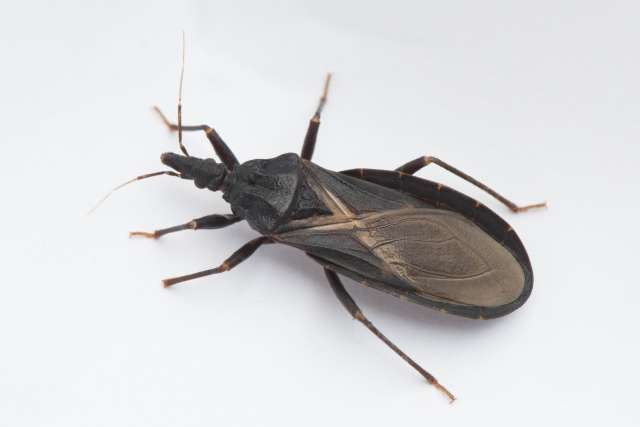This article was updated Sept. 2, 2025.
Chagas disease, a potentially deadly condition transmitted by an insect known as the “kissing bug,” is now endemic in the United States, according to a September report issued by the Centers for Disease Control and Prevention.
The disease is already considered endemic in Latin America, where an estimated 8 million people are infected but most don’t know it, the CDC says. Researchers contend that recognizing Chagas disease as endemic here will support more effective education about the condition in medical schools and better prepare physicians to identify it.
Experts estimate about 45,000 people in Los Angeles County are infected — among more than 300,000 in the United States — and fewer than 2% of them know they carry the parasite transmitted by the “kissing bug.”
“Most people living with Chagas disease are unaware of their diagnosis, often until it’s too late to have effective treatment,” says Judith Currier, MD, chief of infectious diseases at UCLA Health.
Also known as the conenose bug, barber bug or vinchuca in Spanish, “kissing bugs” — so named because they bite people on the face — feast on human blood. After they bite, they defecate, which deposits the parasite they carry, known as T. cruzi, onto the skin.
When the bitten person scratches the itchy bite, they inadvertently rub the parasite into the wound, which is how it enters the bloodstream, explains Shaun Yang, PhD, a professor of clinical microbiology at the David Geffen School of Medicine at UCLA.
A silent disease with serious potential consequences
Many people with Chagas disease are asymptomatic throughout its acute and chronic phases.
During the acute phase, which lasts about two months, some people experience severe swelling of the eyelid, “which is almost a hallmark of acute Chagas infection,” Dr. Yang says. Other acute symptoms may include fever, fatigue, body aches, headache, loss of appetite, diarrhea and vomiting. But because these symptoms are similar to those of other illnesses, most people don’t immediately consider the source to be infection with the T. cruzi parasite.
During the chronic phase of the disease, which can last a lifetime, about 20% of those infected will develop serious heart or digestive problems. Chagas disease can cause an enlarged heart, heart failure or cardiac arrest; an enlarged colon; or an enlarged esophagus.
Left untreated, Chagas disease “kills the heart very slowly,” Dr. Yang says.
UCLA Health patients with symptoms of heart trouble — such as swelling of the legs, shortness of breath or chest pain — who are diagnosed with heart disease, undergo a blood test for Chagas disease, says Joanna Schaenman, MD, PhD, an infectious diseases physician and researcher who works with transplant patients.
Some patients can manage their condition with cardiac medication to treat heart failure, while others may need a heart transplant.
“Patients with Chagas disease as cause of end stage heart failure generally do very well after heart transplantation,” Dr. Schaenman says. “And they can live a full and high-functioning life after the transplant.”
Transplantation, however, can “reactivate” Chagas disease in those infected, so patients are monitored regularly to check for recurrence of the disease. If Chagas returns, these patients can be treated with anti-parasite medication, Dr. Schaenman says.
However, anti-parasite medications are only effective against Chagas during the acute phase or recurrence after a transplant.
“Unfortunately, if you’re antibody positive, indicating a past exposure to Chagas disease, there's no medication that's effective to treat it at that point in time,” Dr. Schaenman says. “But I think it would be useful for that person to be aware so that they can monitor for the development of any symptoms and just realize that they’re at higher risk for developing heart failure because of that parasite exposure.”
Who should be tested for Chagas disease?
People who are from Mexico, Central America or South America, or who have a history of travel to those areas, who start experiencing heart problems should be tested for Chagas disease, Dr. Yang says. He advises people visiting rural areas in Latin America to sleep under a net to protect against bug bites.
Kissing bugs can also be found in the United States. Tests indicate that the insects found in Los Angeles are unlikely to carry the parasite that causes Chagas disease. Kissing bugs in Texas, however, have been found to carry the T. cruzi parasite.
“The kissing bugs in the endemic area — Latin America — almost all of them carry the parasite,” Dr. Yang says.
“With global warming, there’s concern among scientists that the borders for where endemic infections occur are shifting northward,” Dr. Schaenman adds.
Kissing bugs are most often found in homes made of mud or adobe. They like to live in cracks in walls, Dr. Yang says, or in areas where there are pets or rodents. The bugs also bite rodents, dogs and cats, he says, “but if they have a choice, they like to bite humans better.”
Chagas disease can also be transmitted from a pregnant person to their fetus, through organ transplantation and blood transfusion, and through consumption of uncooked food contaminated with T. cruzi.
The blood supply in the United States has been tested for Chagas disease since 2007, according to the CDC. About one in 27,500 donors tests positive for Chagas disease.






